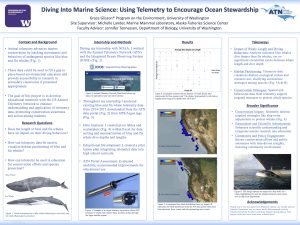Diving into Marine Science: Using Telemetry to Teach Ecological Responsibility
Animal telemetry, the science of gathering information on the movement and behavior of marine organisms using animal-borne sensors or electronic tags, is a powerful tool for studying elusive species such as blue and fin whales. Inspired by the need to utilize animal telemetry in education and deepen understanding of marine conservation, this project aims to integrate real-world scientific data into high school curricula by utilizing animal telemetry, motivated by the need to deepen understanding of marine conservation and inspire environmental stewardship. The U.S. Animal Telemetry Network (ATN) provides unity, stability, and continuity for collecting and managing marine telemetry data, vital for protecting endangered species and informing ecosystem-based management. Telemetry data obtained remotely, in real-time or archival mode from satellites enables researchers to document movements and survival of aquatic animals in relation to environmental variables, aiding in mitigating anthropogenic threats. During my NOAA internship with the ATN, I developed an educational lesson plan using telemetry data to explore the behavior and ecology of blue and fin whales. Despite their protected status under the Endangered Species Act, blue and fin whales face ongoing threats. Understanding their movements and behavior through telemetry data is crucial for effective conservation. This study analyzed telemetry data from 22 blue and fin whales, aiming to equip students with data analysis skills and foster environmental stewardship. By translating complex scientific research into accessible educational content, this approach prepares future generations to address global environmental challenges and nurture a sense of responsibility towards marine ecosystems.
